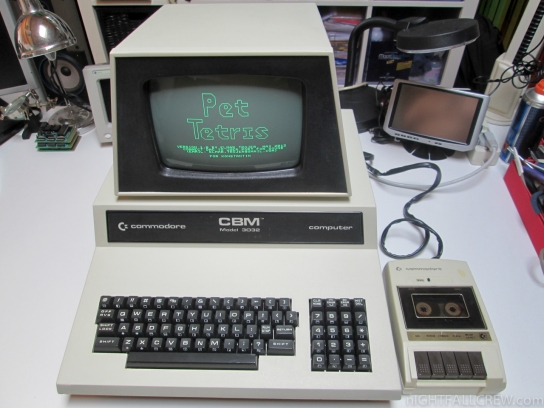Commodore CBM (PET) 3032

Autopsy:
The Commodore CBM (PET) 3032 is a successor to the Commodore PET 2001, it has a bigger keyboard and 32KB dynamic RAM memory. The larger keyboard means that the first cassette drive now has to be an external unit.
from Wikipedia:
The Commodore PET (Personal Electronic Transactor) was a home/personal computer produced from 1977 by Commodore International. A top-seller in the Canadian and United States educational markets, it was Commodore’s first full-featured computer, and formed the basis for their entire 8-bit product line.
The PET 2001 was announced at the Winter CES in January 1977 and the first 100 units were shipped later that year in October. However, the PET was back-ordered for months and to ease deliveries, early in 1978 Commodore decided to cancel the 4 kB version (also because the user would be left with barely 3 kB of RAM).
Although the machine was fairly successful, there were frequent complaints about the tiny calculator-like keyboard, often referred to as a “chiclet keyboard” because the keys resembled the gum candy. The key tops also tended to rub off easily. Reliability was fairly poor, although that was not atypical of many early microcomputers. Because of the poor keyboard on the PET, external replacement ones quickly appeared.
In 1979, Commodore replaced the original PET 2001 with an improved model known as the 2001-N (the N was short for “New”). The new machine used a standard green-phosphor monitor in place of the light blue in the original 2001. It now had a conventional, full-sized keyboard and no longer sported the built-in cassette recorder. The kernel ROM was upgraded to add support for Commodore’s newly-introduced disk drive line. It was offered in 8kB, 16kB, or 32kB models as the 2001-N8, 2001-N16, and 2001-N32 (the 8kB models were dropped soon after introduction). Finally, Commodore added a machine-language monitor to the kernel ROM that could be accessed by jumping to any memory location with a BRK instruction. It did not include a built-in assembler and required the user to enter hexadecimal numbers for coding.
Sales of the newer machines were strong, and Commodore then introduced the models to Europe. The result was the CBM 3000 series (‘CBM’ standing for Commodore Business Machines), which included the 3008, 3016 and 3032 models. Like the 2001-N-8, the 3008 was quickly dropped. The change to CBM occurred because of a trademark dispute with Philips over the PET name.
source: wikipedia


















Recent Comments